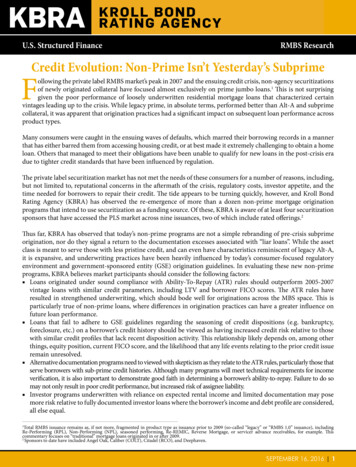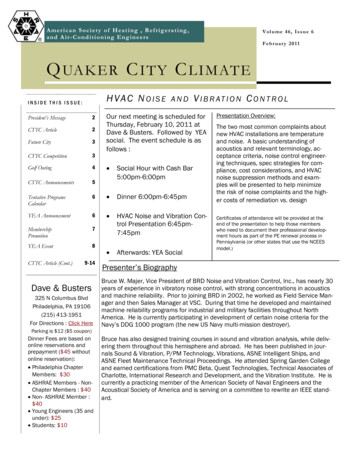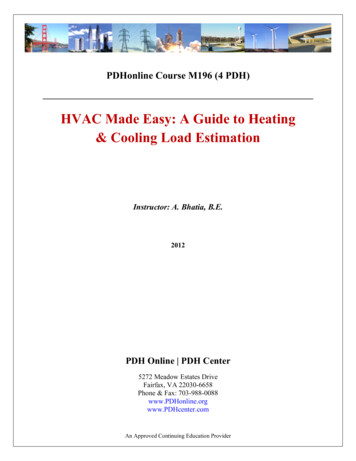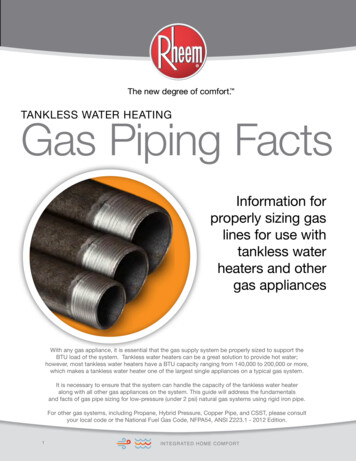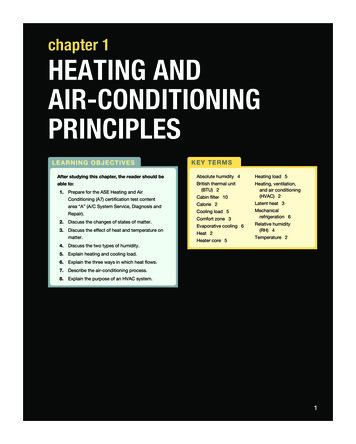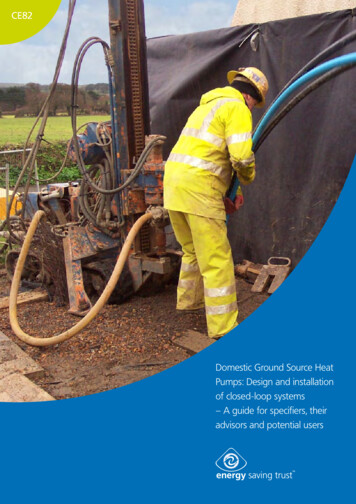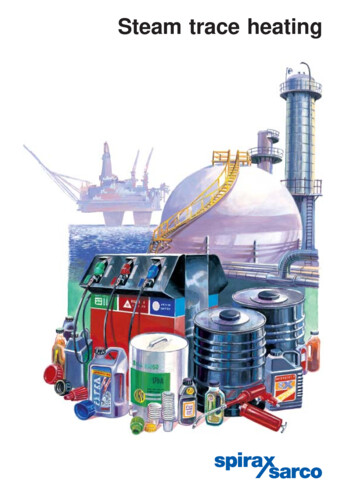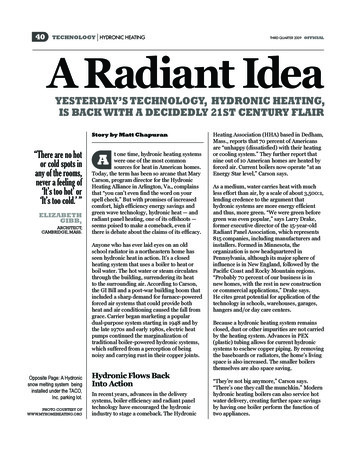
Transcription
eOFFICIAL 3rd Quarter 09 Layout:Layout 1 10/29/09 2:01 PM Page 4040TECHNOLOGY HYDRONIC HEATINGTHIRD QUARTER 2009 OFFICIALA Radiant IdeaYESTERDAY’S TECHNOLOGY, HYDRONIC HEATING,IS BACK WITH A DECIDEDLY 21ST CENTURY FLAIRStory by Matt Chapuran“There are no hotor cold spots inany of the rooms,never a feeling of‘It’s too hot’ or‘It’s too cold.’ ”ELIZABETHGIBB,ARCHITECT,CAMBRIDGE, MASS.At one time, hydronic heating systemswere one of the most commonsources for heat in American homes.Today, the term has been so arcane that MaryCarson, program director for the HydronicHeating Alliance in Arlington, Va., complainsthat “you can’t even find the word on yourspell check.” But with promises of increasedcomfort, high efficiency energy savings andgreen wave technology, hydronic heat — andradiant panel heating, one of its offshoots —seems poised to make a comeback, even ifthere is debate about the claims of its efficacy.Anyone who has ever laid eyes on an oldschool radiator in a northeastern home hasseen hydronic heat in action. It’s a closedheating system that uses a boiler to heat orboil water. The hot water or steam circulatesthrough the building, surrendering its heatto the surrounding air. According to Carson,the GI Bill and a post-war building boom thatincluded a sharp demand for furnace-poweredforced air systems that could provide bothheat and air conditioning caused the fall fromgrace. Carrier began marketing a populardual-purpose system starting in 1948 and bythe late 1970s and early 1980s, electric heatpumps continued the marginalization oftraditional boiler-powered hydronic systems,which suffered from a perception of beingnoisy and carrying rust in their copper joints.Opposite Page: A Hydronicsnow melting system beinginstalled under the TACO,Inc. parking lot.PHOTO COURTESY OFwww.MYHOMEHEATING.ORGHydronic Flows BackInto ActionIn recent years, advances in the deliverysystems, boiler efficiency and radiant paneltechnology have encouraged the hydronicindustry to stage a comeback. The HydronicHeating Association (HHA) based in Dedham,Mass., reports that 70 percent of Americansare “unhappy (dissatisfied) with their heatingor cooling system.” They further report thatnine out of 10 American homes are heated byforced air. Current boilers now operate “at anEnergy Star level,” Carson says.As a medium, water carries heat with muchless effort than air, by a scale of about 3,500:1,lending credence to the argument thathydronic systems are more energy efficientand thus, more green. “We were green beforegreen was even popular,” says Larry Drake,former executive director of the 15-year-oldRadiant Panel Association, which represents815 companies, including manufacturers andinstallers. Formed in Minnesota, theorganization is now headquartered inPennsylvania, although its major sphere ofinfluence is in New England, followed by thePacific Coast and Rocky Mountain regions.“Probably 70 percent of our business is innew homes, with the rest in new constructionor commercial applications,” Drake says.He cites great potential for application of thetechnology in schools, warehouses, garages,hangers and/or day care centers.Because a hydronic heating system remainsclosed, dust or other impurities are not carriedby the heating system. Advances in PEX(plastic) tubing allows for current hydronicsystems to eschew copper piping. By removingthe baseboards or radiators, the home’s livingspace is also increased. The smaller boilersthemselves are also space saving.“They’re not big anymore,” Carson says.“There’s one they call the munchkin.” Modernhydronic heating boilers can also service hotwater delivery, creating further space savingsby having one boiler perform the function oftwo appliances.
eOFFICIAL 3rd Quarter 09 Layout:Layout 1 10/29/09 2:02 PM Page 41OFFICIAL THIRD QUARTER 2009HYDRONIC HEATINGTECHNOLOGY41
eOFFICIAL 3rd Quarter 09 Layout:Layout 1 10/29/09 2:02 PM Page 4242TECHNOLOGY HYDRONIC HEATINGTHIRD QUARTER 2009 OFFICIALCambridge, Mass., architect Elizabeth Gibbselected radiant hydronic heat for her new4,000-square-foot home. “My husband, whois German, grew up in Italy and Germany,where hydronic heating is commonplace.This form of heating produces very even,stable temperatures, produces no sound(therefore is completely silent), and from mypoint of view as an architect is invisible in theinterior spaces.” Gibb also cites cost savings,and an attendant environmental benefit. “Theoperating cost savings are significant,” Gibbsays. “The mass of concrete slab under eachfloor retains heat for a long time.”By warming from beneath, the homeownerenjoys an immediate benefit of a warm floorin the morning. By charging the concretesubfloor, the floors themselves and thefurniture become the mediums for transferringenergy. This allows the heat to be more evenlydistributed across the home’s footprint,alleviating drafts.Above: Workers installingpavers over a Hydronicsnow melting system.“There are no hot or cold spots in any of therooms, never a feeling of ‘It’s too hot’ or ‘It’stoo cold.’ ” Gibb says. “It is a gentle, even heatthat is calibrated to be at its optimum at about5-foot-6-inches from the floor. Walking on ourwood floors is a pleasure because the floorsare always warm and never even cool, even onthe coldest days.”RIght: The snow meltingsystem doing its job duringthe Winter season.PHOTOS COURTESY OFwww.MYHOMEHEATING.ORGMost systems heat from the top down, wherehydronic radiant technology permits for theheat to rise. “There’s very little stratificationfrom floor to ceiling,” Drake says, citing onestudy where hydronic heat was employed in abuilding with a 20-foot tall ceiling. The heat atthe top of the room was almost identical;within a few degrees, Drake says, of the floor.“There are no drafts at your ankles nor toomuch heat up at your head,” he says.Radiant FloorsWhile the technology of hydronic heat ismostly associated with baseboards orradiators, hydronic radiant heat works byembedding flexible plastic tubing into theconcrete or in the subflooring. By snakingplastic tubes beneath floors, radiant panelsystems deliver heat directly into the floors,walls or furniture. Whereas forced airductwork systems rely on heat or cool airbeing pushed into an environment, kicking updrafts and resulting in greater circulation ofdust and spores, hydronic and radiant systemsare closed.Snaking a network of plastic tubing in thesubflooring allows for greater sophisticationof the system, as well, according to Gibb.Implementation of programmable thermostatsallow for temperature zoning, leaving somerooms at cooler temperature than others. “Ourguest room is rarely used in the wintermonths,” Gibb says. “So, we keep the doorclosed and set the temperature at 60 degrees.”The plastic tubing network can also providenumerous ancillary benefits, such as runninga separate closed system off the radiator intothe outside, to provide snow melting in the
eOFFICIAL 3rd Quarter 09 Layout:Layout 1 10/29/09 2:02 PM Page 43OFFICIAL THIRD QUARTER 2009HYDRONIC HEATINGTECHNOLOGY43driveway, provided an anti-freeze additive isintroduced to that portion of the network. Thesystem can heat a hot tub or pool or even runthrough towel racks to provide hot towels inthe morning.InstallationThe efficacy of the system largely dependsupon the subflooring. With tubing embeddeddirectly into a concrete slab floor, there needsto be insulation installed directly beneath thepiping to direct the heat above, or — in thecase of pipes running in air pockets in thesubflooring — dehumidifiers to preventdamage from condensation. Radiant heatworks best beneath ceramic tile floors, givenceramic’s capacity to hold heat. Conversely,deep pile carpet can have an insulating effect,preventing the free passage of heat into theliving area.Above: Plastic tubing is laidat precise measurementson the subfloor.Embedding the system in the concreteobviously poses some threat of damage andcould make it difficult to find a leak. “Weseldom see a defect in the tube,” Drake says.“There could be damage in the tube, but thenyou drill down into the concrete and repatchwhen you’re done. Otherwise, the tubing iswell protected. Once it’s there, it’s there.”Left: A manifold isdesigned to provide shortpiping distances forconsistant heat distributionand the ability to havetemperature zoning.Drake’s organization mandates a 100 psipressure test for the installation of tubing andoffers a certification program, including aknowledge exam. The technology probablybecomes less desirable, “south of theMason/Dixon line,” Drake says, “where heatbecomes subservient to air conditioning.”PHOTOS BY: BETH GIBBSwww.MYHOMEHEATING.ORGIt Cools, Too?Hydronic and radiant systems can provide airconditioning, replicating the effect of enteringa cool basement by running cold waterthrough the floor. “Your body radiates heat tothe cool surface,” Drake says. “It’s like walkingclose to the frozen food section in a store.”“We’ve seen an increase in demand onhydronic air handlers,” confirms LeeEnsminger, sales manager for Crown Boilerin Philadelphia. Today, a boiler with ahydronic air handler can be retrofitted ontoexisting ductwork installed for electric forcedhot air to create a hybrid system with multipleuses. Crown Boiler’s Santa Fe II series ofheating and cooling air handlers not onlyheats air, but can cool it, as well.“With a hydronic air handler, you have heatfor the house, but also a D/X coil for cooling.”Ensminger says, adding that the applicationof the D/X cool can be very effective forretrofits or households with a standardhydronic baseboard heating system, but withan owner-identified need for additionalcooling, such as in a new addition being builtoff the household.“Radiant floor tubing is great for rooms like akitchen, but not as good for carpet,” Ensmingersays. The D/X coil is hooked up to an outdoorcondensing unit to utilize existing duct work
eOFFICIAL 3rd Quarter 09 Layout:Layout 1 10/29/09 2:02 PM Page 4444TECHNOLOGY HYDRONIC HEATINGTHIRD QUARTER 2009 OFFICIALmodifications in a radiant slab, such asincreased insulation in the floor and weathertightening windows to prevent heat loss anddrafts, can actually provide much of thedesired benefits of increased efficiency andcomfort without the additional costs of systeminstallation. Wilson also questions some of theunderlying assumptions for its use.“If the total design heat load of a house is only15,000 BTUs per hour, a radiant slab can't bemaintained more than a degree or two abovethe indoor air temperature or overheating willoccur,” Wilson says. “And if the floor slab isonly 75 degrees, it's not going to feel warmunderfoot, because your feet will still beconducting heat into the slab. As a result, youwon't get the benefit of a slab being warmunderfoot, one of the most attractive featuresof this heat distribution system.Self leveling lightweightconcrete is poured over thehydronic tubing topermanently embed itinto place.“It's not that I'm opposed to hydronic heatingor even radiant-floor heating systems; it's justthat in new construction, I believe it makesmore sense to put your money into envelopeimprovements.”PHOTOS BY: BETH GIBBSwww.MYHOMEHEATING.ORGto create cooling. Although the creation ofa hybrid system lessens one of the chiefadvantages of a hydronic system — that itsclosed nature reduces the circulation ofparticulates in the household — a hybridsystem permits radiant heat in tiled roomslike the kitchen or great room and forced airconditioning in the bedrooms for advancedcomfort at night.Are the Savings There?Two lingering questions on the advent ofradiant heat are the cost of installation and ifits claims of higher efficacy and comfortwithstand scrutiny. Gibb concedes that,“a hydronic radiant heating installation doescome with additional costs.”More troubling is an article in EnvironmentalBuilding News in which Executive Editor AlexWilson argues that the necessary homeEnergy Star, an environmental advocacydivision of the Environmental ProtectionAgency, cites improved installation as thefirst step for ensuring increased efficiency inthe home. Among its “5 Steps You Can Taketo Reduce Air Pollution,” one is “Seal up yourhome. Drafty windows and doors, cold wallsor ceilings, and high energy bills are allsymptoms of energy leaks. Seal air leaks, addinsulation and choose Energy Star qualifiedwindows when replacing old windows.” Aftermaking these upgrades, spending extra moneyfor a radiant panel system just may not makesense.“Investing so much money in the buildingenvelope and still putting in an expensiveradiant-floor heating system eliminates thepotential for offsetting much of the extra costin building envelope improvements throughsavings in the mechanical equipment — oneof the key principles of integrated, wholesystems building design,” Wilson concludes.Even if one should approach radianttechnology with some caution, the U.S.Department of Energy does agree that radiantheating systems are “usually more efficientthan forced-air heating because no energy islost through ducts.”
heating system that uses a boiler to heat or boil water. The hot water or steam circulates through the building, surrendering its heat . “There’s one they call the munchkin.” Modern hydronic heating boilers can also service hot water delivery, creating further space


